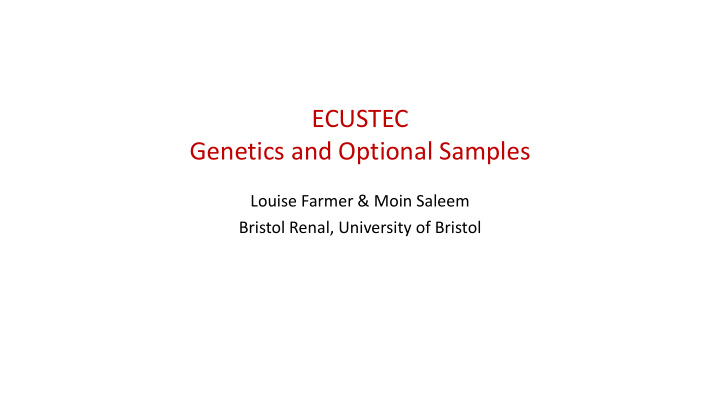



ECUSTEC Genetics and Optional Samples Louise Farmer & Moin Saleem Bristol Renal, University of Bristol
Introduction • We are interested in two aspects of the pathogenesis of HUS - Are there genetic mutations that predispose to a sensitivity to HUS? - What is occurring in the podocyte/endothelial cells in HUS? Hypothesis • The podocyte is a central target of Shiga-toxin damage Cormack, D.H. Ham’s Histology, 9th ed., • Podocyte prevents complement inhibition via reduction in podocyte VEGF secretion Lippincott, Philadelphia, 1987, p. 578. • Leads to thrombotic microangiopathy Healthy HUS Podocyte Podocyte Urinary Space VEGF VEGF GBM GBM Endothelium Endothelium VEGFR2 VEGFR2 FH C3b iC3b C3b Complement Blood Complement Inhibition Activation
Genetics blood Sample • 4ml sample taken between obtaining consent and day 8. • Investigate genetic susceptibility to STEC-HUS. • Focus on any polymorphisms associated with altered complement regulation. Optional Samples • Lithium heparin blood (volume dependent on body weight) at day 1, 2, 4, 6, 8 and 30. • Urine day 1, 4, 8 and 30 (where possible) • Patients >15 kg based in Bristol will be asked for an additional 10ml – time critical.
Cell Culture at Bristol Renal • Isolated and conditionally immortalised cell lines from healthy kidneys - replicate at 33°C - differentiate at 37°C • Can co-culture podocytes and endothelial cells together to give a more accurate representation of in vivo conditions • Serum from patients and healthy controls can be incubated with these cells - Lyse and blot for C3, VEGF, Factor H etc to see if patient serum causes up/down regulation - Run ELISAs on cell culture supernatant to assess complement/VEGF synthesis • Do these effects decrease with the use of eculizumab? • Placebo vs treatment Podocyte 37 Podocyte 33 Differentiated
Complement activation • Proof of principle – complement activation with rabbit serum • Control is heat inactivated human serum Factor H C3d C4d Control serum Rabbit serum
Spheroids • Can co-culture podocytes and endothelial cells in the form of spheroids • Come together to form a GBM Courtesy of Jack Tuffin, University of Bristol
Neutrophil Isolation • The mechanism of delivery of Shiga-toxin (Stx) to the podocyte is currently unknown • Neutrophils will be isolated from a small number of local patients (local patients only due to time critical nature of isolation) • These neutrophils can be added to co-cultures and spheroids to see if addition of neutrophils from STEC-HUS patients causes complement activation/VEGF reduction • Compared to neutrophils from healthy controls and placebo.
Shiga-Toxin • We are currently carrying out experiments with Shiga toxin at Bristol Renal • We can add this to our co-culture experiments to see if addition of shiga toxin directly to cells causes similar effects to addition of plasma/neutrophils from STEC-HUS patients 150 % cell viability 100 Differentiated human podocytes incubated with 0.1ng/ml of *** Shiga toxin for 0.5-48 hours as shown. *** 50 Viability of podocytes is significantly reduced. 0 l r r r r r r r n n o h h h h h h h i i r g c 1 2 t 5 4 6 4 8 y r n . x x 2 4 a m 0 x x o t t g t t x x S S C o x S S i t t s t S S r a S p u i a P d h e T M Courtesy of Emily Bowen, University of Bristol
Urine Samples • Precipitate protein and blot for C3, VEGF and FactorH • Run ELISA’s for C3, VEGF and FactorH against control urines • As these are across several time points during disease we will look to see if we can identify when podocyte injury occurs • Could this be a novel biomarker for disease? Urinary space C3 FH VEGF Podocyte GBM Endothelium
Thank You! • A huge thank you to the patients and their families for agreeing to participate • Everyone involved in recruiting patients and taking samples • Everyone involved in ECUSTEC • Bristol Renal
Recommend
More recommend